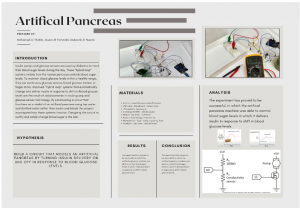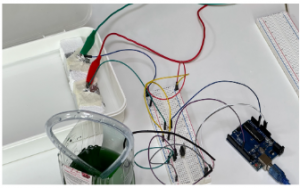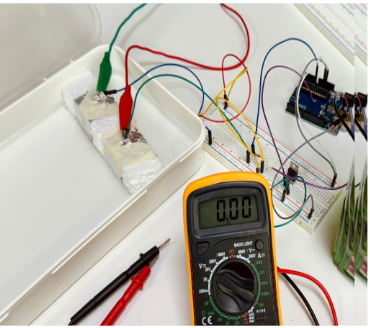Project Artificial Pancreas
by Mohamed Al Shehhi – Jasim Al Yammahi and Mubarak Al Nuaimi
Introduction
People with diabetes must frequently calculate and take insulin based on food intake, physical activity, and blood glucose levels, even during the night. Advances in insulin pumps and glucose sensors have led to “hybrid loop” systems that automatically adjust insulin delivery, mimicking the human pancreas. This is known as an artificial pancreas. In this project, you will build a model circuit using tap water and distilled water to simulate an artificial pancreas, aiming to quickly and safely adjust “blood sugar” levels.
Project Background
For our school project, we created a model to demonstrate how an artificial pancreas works to automatically manage blood sugar levels in people with Type 1 diabetes. This innovative device combines:
- Insulin Pump: Delivers precise insulin doses.
- Continuous Glucose Monitor (CGM): Continuously tracks blood glucose levels.
- Advanced Algorithms: Adjust insulin delivery based on CGM data.
These components work together to mimic the pancreas, automating insulin delivery and reducing the need for manual management.
Methodology

In the methodology, we started by learning about diabetes and creating the artificial pancreas system. This system has three parts: a continuous glucose monitor (CGM), an insulin pump, and a control algorithm. We gathered materials like the CGM, insulin pump, microcontroller, and other things we needed. Then, we put everything together, making sure they could all talk to each other properly. Next, we programmed the microcontroller to check glucose levels and give insulin using a special plan we made. We tested the system a lot to make sure it worked well. We also made the plan better to make the system work even better. We wrote down what happened during testing and looked at how well the system worked. We compared it to how diabetes is usually managed. Finally, we looked at how good the system was and talked about what else it could be used for in the future.
Project development
 In project development, we moved through three main steps: coming up with the idea, checking if it could work, and making a small version to test. First, we brainstormed ideas for the artificial pancreas to help with diabetes. Then, we looked into if our idea could actually work by doing some research. After that, we made a small model to see if it could do what we wanted. All along, we kept in mind the challenges people with diabetes face, making sure our project could help solve them.
In project development, we moved through three main steps: coming up with the idea, checking if it could work, and making a small version to test. First, we brainstormed ideas for the artificial pancreas to help with diabetes. Then, we looked into if our idea could actually work by doing some research. After that, we made a small model to see if it could do what we wanted. All along, we kept in mind the challenges people with diabetes face, making sure our project could help solve them.
Implementation
In the implementation phase, we tested the artificial pancreas using water. We used both sink water and distilled water to check how well the system worked. Key steps included setting up the tests, running them, and looking at the results to make sure the device worked correctly.
For long-term sustainability:
Maintenance: Regular check-ups and updates for the device.
Adaptation: Making sure the system can change with new conditions and technologies.
Training: Teaching users how to use and take care of the device.
These steps help keep the device working well and up-to-date.
How is Our Project Related to UN Sustainable Development Goals (SDGs):
SDG 1: No Poverty
Healthcare Affordability: Our project aims to improve diabetes management, reducing healthcare expenses associated with complications. By making treatment more accessible, we contribute to alleviating financial burdens on families.
SDG 3: Good Health and Well-being
Improved Health Outcomes: Our artificial pancreas model enhances blood sugar control, lowering the risk of diabetes-related complications and promoting overall well-being.
Enhanced Quality of Life: Automating insulin delivery eases the daily burden on diabetes patients, enhancing their quality of life and mental health.
SDG 4: Quality Education
Educational Value: Our project fosters STEM learning by engaging students in developing and understanding advanced medical technology.
Health Education: By raising awareness about diabetes management and innovative solutions, we promote proactive health education within communities.
Results
The experiment was successful, demonstrating that the artificial pancreas model effectively controls blood sugar levels. The machine delivered insulin in response to changes in glucose levels accurately.
Using sensors, the circuit monitored simulated blood glucose. When levels changed, the system adjusted insulin delivery, maintaining stability with tap water as blood and distilled water as insulin.
This success shows that an artificial pancreas can automate blood sugar regulation, reducing the need for manual monitoring and improving diabetes management and patient quality of life.




